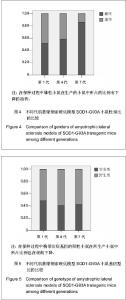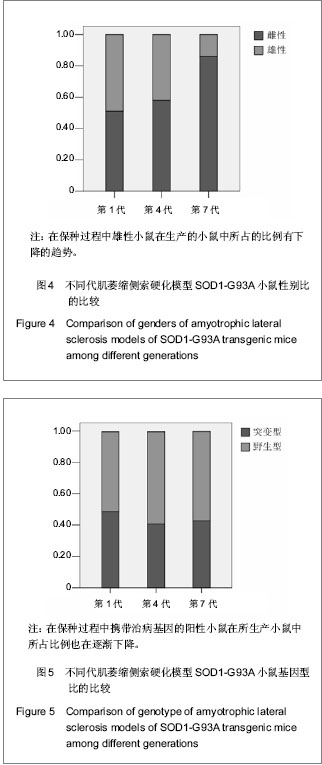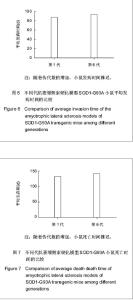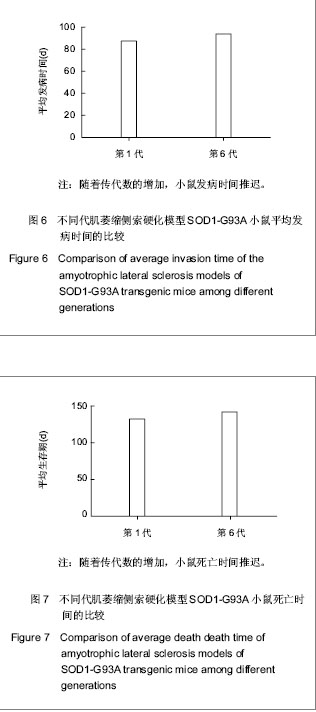Chinese Journal of Tissue Engineering Research ›› 2013, Vol. 17 ›› Issue (24): 4521-4528.doi: 10.3969/j.issn.2095-4344.2013.24.022
Previous Articles Next Articles
Germline degradation of a mouse model of familial amyotrophic lateral sclerosis when breeding
Cai Bin, Fan Dong-sheng
- Peking University Third Hospital, Beijing 100191, China
-
Received:2013-01-17Revised:2013-02-26Online:2013-06-11Published:2013-06-11 -
Contact:Fan Dong-sheng, M.D., Chief physician, Professor, Researcher, Doctoral supervisor, Peking University Third Hospital, Beijing 100191, China dsfan@sina.com -
About author:Cai Bin★, Master, Peking University Third Hospital, Beijing 100191, China caibin@bjmu.edu.cn -
Supported by:National Natural Science Foundation of China, No. 81030019*, 30871359*; Beijing Natural Science Foundation, No. 7082099*, 7102161*; Doctoral Fund of Ministry of Education, No. 20100001110084*; Capital Medical Science and Technology Development Fund, No. SF-2009-III-34*
CLC Number:
Cite this article
Cai Bin, Fan Dong-sheng. Germline degradation of a mouse model of familial amyotrophic lateral sclerosis when breeding[J]. Chinese Journal of Tissue Engineering Research, 2013, 17(24): 4521-4528.
share this article
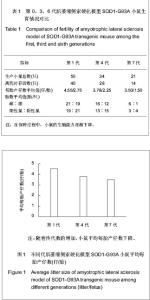
2.1 不同代小鼠的生育情况 引进后的小鼠记为第0代,共8只,其中8周B6SJL SOD1G93A/+半合子雄性种鼠4只,8周B6SJLF1/J+/+雌鼠4只,按之前文献报道的方法进行合笼交配[16],经交配后所生产的小鼠记为第1代。 第0代小鼠交配后所生产的第1代小鼠共50只,离乳时存活40只,平均每胎生产4.55只小鼠,每只雌鼠平均可生产2.75胎,每只雌鼠全部生育期平均生产12.5只小鼠。第3代生产的小鼠数量即第4代小鼠开始下降,平均每胎生产3.78只小鼠(与第1代比较,t=2.518,P=0.021),每只雌鼠平均可生产2.25胎(与第1代比较,t=1.414,P=0.207),每只雌鼠全部生育期平均生产8.5只(与第1代比较t=3.703,P=0.01)。传至第7代时,每只雌鼠平均每胎仅能生产3.5只小鼠(与第1代比较t=2.495,P=0.025),每只雌鼠平均仅能生产1.5胎(与第1代比较:t=3.273,P=0.017),每只雌鼠全部生育期平均仅能生产5.25只小鼠,与第1代和第4代比较:t 值分别为5.385和2.672,P值分别为0.002和0.037,且用于保种的雌鼠一半以上无法怀孕。以上结果显示在保种过程中,小鼠的生殖能力逐渐下降。 分别对第0,3,6代小鼠的生育情况进行了对比,见表1和图1-3。"

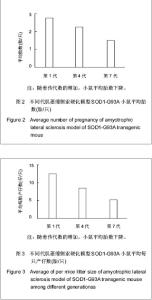
2.2 不同代小鼠性别比及基因型变化情况 第1代、第4代、第7代小鼠的雌雄比分别为21∶19,16∶12, 6∶1,虽然χ2=4.878,P=0.087,3个样本的差异无显著性意义,但可以看出在保种过程中雄性小鼠在生产的小鼠中所占的比例有下降的趋势。而第1代、第4代、第7代小鼠中携带SOD1G93A基因的杂合子突变型小鼠与不携带该致病基因的纯合子野生型小鼠的比分别为19∶21,13∶15,3∶4,虽然χ2=0.09,P=0.956,3个样本的差异也无显著性意义,但也可以看出在保种过程中携带治病基因的阳性小鼠在所生产小鼠中所占的比例也在逐渐下降。由于雄性小鼠以及携带SOD1G93A基因的阳性小鼠比例的下降,而且小鼠的生殖能力也显著下降,因此在第七代小鼠中没能得到携带SOD1G93A基因的杂合子突变型雄鼠,而保种过程中需要B6SJL SOD1G93A/+半合子雄性小鼠与B6SJLF1/J+/+雌鼠进行交配,所以保种无法进行下去导致了实验室该品系转基因小鼠的保种失败。在保种过程中,每1代所生产小鼠的性别比例以及携带SOD1G93A基因的阳性小鼠所占的比例也发生了变化,见表1和图4-5。"
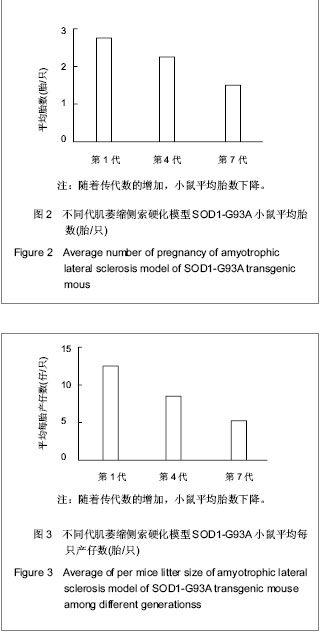
| [1] Pratt A J, Getzoff E D, Perry J J. Amyotrophic lateral sclerosis: update and new developments. Degener Neurol Neuromuscul Dis.2012;2012(2):1-14.http://www.ncbi.nlm.nih.gov/pubmed/23019386[2] Benkler C, Offen D, Melamed E, et al. Recent advances in amyotrophic lateral sclerosis research: perspectives for personalized clinical application. EPMA J.2010;1(2):343-361.http://www.ncbi.nlm.nih.gov/pubmed/23199069[3] Venkova-Hristova K, Christov A, Kamaluddin Z, et al. Progress in therapy development for amyotrophic lateral sclerosis. Neurol Res Int. 2012;2012:187234.http://www.ncbi.nlm.nih.gov/pubmed/22830014[4] Naganska E, Matyja E. Amyotrophic lateral sclerosis - looking for pathogenesis and effective therapy. Folia Neuropathol.2011;49(1):1-13.http://www.ncbi.nlm.nih.gov/pubmed/21455838[5] Thonhoff JR, Ojeda L, Wu P. Stem cell-derived motor neurons: applications and challenges in amyotrophic lateral sclerosis. Curr Stem Cell Res Ther. 2009;4(3):178-199.http://www.ncbi.nlm.nih.gov/pubmed/19492980[6] Hefferan MP, Galik J, Kakinohana O, et al. Human neural stem cell replacement therapy for amyotrophic lateral sclerosis by spinal transplantation. PLoS One.2012;7(8):e42614.http://www.ncbi.nlm.nih.gov/pubmed/22916141[7] Wang DB, Gitcho MA, Kraemer BC, et al. Genetic strategies to study TDP-43 in rodents and to develop preclinical therapeutics for amyotrophic lateral sclerosis. Eur J Neurosci.2011;34(8):1179-1188.http://www.ncbi.nlm.nih.gov/pubmed/21777407[8] Rosen DR. Mutations in CuZn superoxide dismutase gene are associated with familial amyotrophic lateral sclerosis. Nature.1993;362:59-62.http://www.ncbi.nlm.nih.gov/pubmed/8446170[9] Turner BJ, Talbot K. Transgenics, toxicity and therapeutics in rodent models of mutant SOD1-mediated familial ALS. Prog Neurobiol.2008;85(1):94-134.http://www.ncbi.nlm.nih.gov/pubmed/18282652[10] Julien J. Mouse models of amyotrophic lateralsclerosis. Drug Discovery Today: Disease Models. 2006;3(4):331-339.http://www.sciencedirect.com/science/article/pii/S1740675706000727[11] Mali Y, Zisapel N. A novel decoy that interrupts G93A-superoxide dismutase gain of interaction with malate dehydrogenase improves survival in an amyotrophic lateral sclerosis cell model. J Med Chem. 2009;52(17):5442-5448.http://www.ncbi.nlm.nih.gov/pubmed/19670830[12] Koh SH, Lee YB, Kim KS, et al. Role of GSK-3beta activity in motor neuronal cell death induced by G93A or A4V mutant hSOD1 gene. Eur J Neurosci. 2005;22(2):301-309.http://www.ncbi.nlm.nih.gov/pubmed/16045483[13] Gurney ME, Pu H, Chiu AY. moter neuron degeneration in mice that express a human Cu,Zn superoxide dismutase mutation. Science. 1994;5166(264):1772-1775.http://www.ncbi.nlm.nih.gov/pubmed/8209258[14] Joyce PI, Fratta P, Fisher EM, et al. SOD1 and TDP-43 animal models of amyotrophic lateral sclerosis: recent advances in understanding disease toward the development of clinical treatments. Mamm Genome.2011;22(7-8):420-448.http://www.ncbi.nlm.nih.gov/pubmed/21706836[15] Rj M, Ej B, Aj K, et al. Optimised and Rapid Pre-clinical Screening in the SOD1G93A Transgenic Mouse Model of Amyotrophic Lateral Sclerosis (ALS). Plos One. 2011;6(8):e23244.http://www.ncbi.nlm.nih.gov/pubmed/21876739[16] Huang H, Zhang C, Xi J, et al. Nanfang Yike Daxue Xuebao. 2006;26(3):258-260.黄慧,张成,席静,等. 家族性肌萎缩侧索硬化症转基因鼠的繁殖和鉴定[J]. 南方医科大学学报,2006,26(3):258-260.http://www.cnki.com.cn/Article/CJFDTotal-DYJD200603002.htm[17] Guo YS, Yu JX, Duan WS, et al. Nao yu Shenjing Jibing Zazhi. 郭艳苏,于继徐,段伟松,等. SOD1-G93A转基因小鼠的鉴定方法比较[J]. 脑与神经疾病杂志,2009;17(4): 268-270.http://www.cnki.com.cn/Article/CJFDTotal-LYSJ200904009.htm[18] Henriques A, Pitzer C, Schneider A. Characterization of a novel SOD-1(G93A) transgenic mouse line with very decelerated disease development]. PLoS One. 2010;5(11):e15445.http://www.ncbi.nlm.nih.gov/pubmed/21102999[19] Qian Y, Ye BQ, Geng JG, et al. Shiyan Dongwu yu Bijiao Yixue. 2009;29(2):124-126.钱云,叶步青,耿建国,等. DNA检测技术在基因剔除小鼠保种中的初步应用[J]. 实验动物与比较医学,2009,29(2):124-126.http://www.cqvip.com/Main/Detail.aspx?id=30139998[20] Alves C J, de Santana L P, Dos S A, et al. Early motor and electrophysiological changes in transgenic mouse model of amyotrophic lateral sclerosis and gender differences on clinical outcome. Brain Res. 2011;1394:90-104.http://www.ncbi.nlm.nih.gov/pubmed/21354109[21] Bame M, Pentiak P A, Needleman R, et al. Effect of Sex on Lifespan, Disease Progression, and the Response to Methionine Sulfoximine in the SOD1 G93A Mouse Model for ALS. Gend Med. 2012;9(6):524-535.http://www.ncbi.nlm.nih.gov/pubmed/23217569[22] Herron LR, Miles GB. Gender-specific perturbations in modulatory inputs to motoneurons in a mouse model of amyotrophic lateral sclerosis. Neuroscience. 2012;226:313-323.http://www.ncbi.nlm.nih.gov/pubmed/23000617[23] Huisman MH, de Jong SW, van Doormaal PT, et al. Population based epidemiology of amyotrophic lateral sclerosis using capture-recapture methodology. J Neurol Neurosurg Psychiatry. 2011;82(10):1165-1170.http://www.ncbi.nlm.nih.gov/pubmed/21622937[24] Manjaly ZR, Scott KM, Abhinav K, et al. The sex ratio in amyotrophic lateral sclerosis: A population based study. Amyotroph Lateral Scler.2010;11(5):439-442.http://www.ncbi.nlm.nih.gov/pubmed/20225930[25] Miller RG, Anderson FJ, Bradley WG, et al. The ALS patient care database: goals, design, and early results. ALS C.A.R.E. Study Group. Neurology. 2000;54(1):53-57.http://www.ncbi.nlm.nih.gov/pubmed/10636125[26] Choi CI, Lee YD, Gwag BJ, et al. Effects of estrogen on lifespan and motor functions in female hSOD1 G93A transgenic mice. J Neurol Sci. 2008;268(1-2):40-47.http://www.ncbi.nlm.nih.gov/pubmed/18054961[27] Bromberg M B. Pathogenesis of amyotrophic lateral sclerosis: a critical review. Curr Opin Neurol.1999;12(5):581-588.http://www.ncbi.nlm.nih.gov/pubmed/10590895[28] de Jong S, Huisman M, Sutedja N, et al. Endogenous female reproductive hormones and the risk of amyotrophic lateral sclerosis. J Neurol,2012.http://www.ncbi.nlm.nih.gov/pubmed/22972621[29] Czlonkowska A, Ciesielska A, Gromadzka G, et al. Estrogen and cytokines production - the possible cause of gender differences in neurological diseases. Curr Pharm Des. 2005;11(8):1017-1030.http://www.ncbi.nlm.nih.gov/pubmed/15777251[30] Popat RA, Van Den Eeden SK, Tanner CM, et al. Effect of reproductive factors and postmenopausal hormone use on the risk of amyotrophic lateral sclerosis. Neuroepidemiology. 2006;27(3):117-121.http://www.ncbi.nlm.nih.gov/pubmed/16946622[31] Xiao AQ. Shengwuxue Jiaoxue. 2009;34(4):69.肖安庆.动物"杀婴"为哪般?[J]. 生物学教学,2009,34(4):69.http://www.cnki.com.cn/Article/CJFDTotal-SWJX200904041.htm[32] Günther R, Suhr M, Koch JC, et al. linical testing and spinal cord removal in a mouse model for amyotrophic lateral sclerosis (ALS). J Vis Exp. 2012;(61). pii: 3936.http://www.ncbi.nlm.nih.gov/pubmed/22453893[33] Knippenberg S, Thau N, Dengler R, et al. Significance of behavioural tests in a transgenic mouse model of amyotrophic lateral sclerosis (ALS). Behav Brain Res. 2010;213(1):82-87.http://www.ncbi.nlm.nih.gov/pubmed/20450936[34] Kafkafi N, Yekutieli D, Yarowsky P, et al. Data mining in a behavioral test detects early symptoms in a model of amyotrophic lateral sclerosis. Behav Neurosci. 2008;122(4):777-787.http://www.ncbi.nlm.nih.gov/pubmed/18729631[35] 鲁绍雄,毛华明,鲁立刚,等. 不同初始基因频率下闭锁群体遗传漂变的模拟[J]. 江苏农业学报,2009(5):991-996.http://www.cnki.com.cn/Article/CJFDTotal-JSNB200905008.htm[36] Tonsor S J. Population genomics and the causes of local differentiation[J]. Mol Ecol,2012,21(22):5393-5395.http://www.ncbi.nlm.nih.gov/pubmed/23281496[37] Willi Y, Griffin P, Van Buskirk J. Drift load in populations of small size and low density. Heredity (Edinb). 2013;110(3):296-302.http://www.ncbi.nlm.nih.gov/pubmed/23211785[38] Niemann H, Lucas-Hahn A. Somatic cell nuclear transfer cloning: practical applications and current legislation. Reprod Domest Anim. 2012;47 Suppl 5:2-10.http://www.ncbi.nlm.nih.gov/pubmed/22913555[39] Zheng S, Geghman K, Shenoy S, et al. Retake the center stage--new development of rat genetics. J Genet Genomics. 2012;39(6):261-268.http://www.ncbi.nlm.nih.gov/pubmed/22749013[40] Devoy A, Bunton-Stasyshyn R K, Tybulewicz V L, et al. Genomically humanized mice: technologies and promises. Nat Rev Genet. 2012;13(1):14-20.http://www.ncbi.nlm.nih.gov/pubmed/22179716[41] Xu P, Liu LJ, Yu LL, et al. Zhongguo Bijiao Yixue Zazhi. 2009;19(8):9-14.徐平,刘丽均,郁丽丽,等. 系统低温生物学技术在实验小鼠资源保存中的建立与应用[J]. 中国比较医学杂志,2009,19(8):9-14.http://www.cnki.com.cn/Article/CJFDTotal-ZGDX200908004.htm[42] Saragusty J, Arav A. Current progress in oocyte and embryo cryopreservation by slow freezing and vitrification. Reproduction. 2011;141(1):1-19.http://www.ncbi.nlm.nih.gov/pubmed/20974041[43] Leibo SP. Cryopreservation of oocytes and embryos: optimization by theoretical versus empirical analysis. Theriogenology. 2008;69(1):37-47.http://www.ncbi.nlm.nih.gov/pubmed/18023472 |
| [1] | Wu Guang-wen, Ye Jin-xia, Zheng Chun-song, Chen Wen-lie, Liu Xian-xiang, Ye Hong-zhi . Effect of Tougu Xiaotong capsule on articular cartilage changes in rat models of osteoarthritis [J]. Chinese Journal of Tissue Engineering Research, 2014, 18(49): 7924-7929. |
| [2] | Wang Pei-pei, Yang Peng . Lower limb walking state under different road conditions verified with virtual reality technology [J]. Chinese Journal of Tissue Engineering Research, 2013, 17(35): 6293-6299. |
| [3] | Yin Xiao-peng, Xu Hui-fen, He Hui-yu. Comparison of the biocompatibility of three kinds of antigen-extracted xenogeneic cancellous bone matrices [J]. Chinese Journal of Tissue Engineering Research, 2013, 17(29): 5275-5281. |
| [4] | Xie Hui, Yang Fei, Zhao De-wei, Wang Ben-jie, Cui Da-ping, Wang Wei, Huang Shi-bo. Chondrocyte differentiation of dog bone marrow mesenchymal stem cells co-cultured with Bio-gide collagen membrane in vitro [J]. Chinese Journal of Tissue Engineering Research, 2013, 17(29): 5282-5289. |
| [5] | Lin Wei, Li Xu-dong, Tang Kuang-yun, Hu Jing. Zinc ions improve the stability of titanium implants under the condition of osteoporosis [J]. Chinese Journal of Tissue Engineering Research, 2013, 17(29): 5296-5302. |
| [6] | Li Wei-dong, Cui Zhi-ming, Xu Guan-hua, Fan Jian-bo, Bao Guo-feng, Sun Yu-yu, Wang Ling-ling. Biocompatibility of olfactory ensheathing cells and poly-L-lactic acid reinforced by chitosan in vitro [J]. Chinese Journal of Tissue Engineering Research, 2013, 17(29): 5316-5322. |
| [7] | Wei Wei, Shi Geng-hu, Li Yu-tang, Zhang Bing, Gao Chuang. Research and application progress of visual fixation component separation [J]. Chinese Journal of Tissue Engineering Research, 2013, 17(24): 4553-4560. |
| [8] | . Culture of bone marrow mesenchymal stem cells plus allogenic decalcified bone matrix in the knee cavity of rabbits for tissue engineered cartilage [J]. Chinese Journal of Tissue Engineering Research, 2013, 17(24): 4371-4379. |
| [9] | Xi Yue. Molecular mechanism of spinal cord injury detected using microarray technology [J]. Chinese Journal of Tissue Engineering Research, 2013, 17(24): 4529-4538. |
| [10] | Wen Cai-xiong. Resistance training and protein supplement: Improvement of elderly muscle protein metabolism [J]. Chinese Journal of Tissue Engineering Research, 2013, 17(24): 4545-4552. |
| [11] | Lu Shou-ming, Lu Shou-liang, Sun Tian-wei, Zhang Hang, Wang Qi-ming. Estrogen effects on serum interleukin-8 and interleukin-10 expression in ovariectomized rats with osteoporosis [J]. Chinese Journal of Tissue Engineering Research, 2013, 17(24): 4394-4400. |
| [12] | Adila•Azhati, Zhao Long, Wang Qian, Ma Yi-tong. Cardiac function and electrophysiological characteristics in myocardial infarction rats after tissue engineered cardiac patch transplantation [J]. Chinese Journal of Tissue Engineering Research, 2013, 17(24): 4401-4408. |
| [13] | Shi Yu-lu, Li Xiao-yuan, Cao Mei-na, Yu Shu-yuan, Wang Ping. Simultaneous isolation of myocardial cells and cardiac fibroblasts from neonatal rats [J]. Chinese Journal of Tissue Engineering Research, 2013, 17(24): 4414-4420. |
| [14] | Wang Qi-feng, Wang Zhi-gang, Huang Jing. Left ventricular papillary muscle ablation in canines by ultrasound ablation catheter [J]. Chinese Journal of Tissue Engineering Research, 2013, 17(24): 4409-4413. |
| [15] | Chen Li-ying, Fan Kun-wu, Wang Jin-shui, Yu Xu-ming, Xu Cheng. Gene expression of the skin and sweat glands in different development stages of embryo [J]. Chinese Journal of Tissue Engineering Research, 2013, 17(24): 4421-4428. |
| Viewed | ||||||
|
Full text |
|
|||||
|
Abstract |
|
|||||
